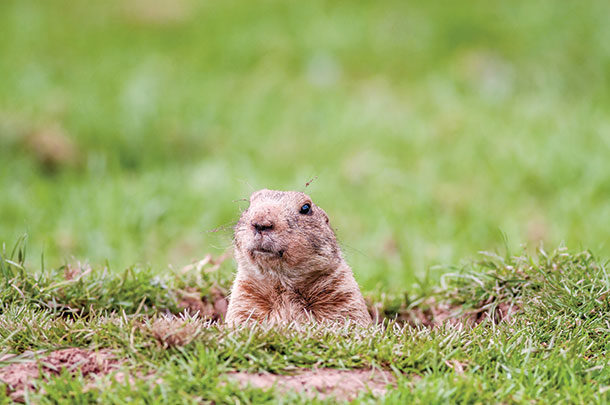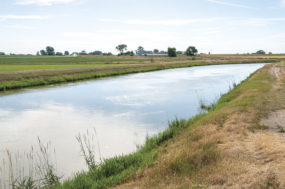For those of you not familiar with Phil, he is a groundhog that annually predicts how soon spring weather will arrive. On Feb. 2, if Phil sees his shadow, there will be six more weeks of winter-like weather. If Phil does not see his shadow, then it will be an “early spring.” The date of Phil’s prognostication is known as Groundhog Day in the U.S. and Canada and has been celebrated since 1887.
Groundhog Day has always interested me because I do not like groundhogs (aka woodchuck and whistle pig). In fact, my dislike has been so extreme in the past some might say it borders on hate. My loathing of these animals comes from the damage they inflicted on crops, fields and, ultimately, equipment when I was farming.
The disdain continues today because my forage research plots seem to have “welcome” signs for every groundhog in the area. An unnoticed groundhog can destroy a research study in a single day and set research projects back by years.
The ancient Chinese warrior Sun Tzu taught his soldiers that they must know their enemy or suffer defeat. Following that logic, I have learned about my enemy the groundhog so I can defeat him. Well, maybe not defeat him but at least slow his attacks. The following is a summary of what I have learned.
Know your enemy
Groundhogs begin hibernating in the fall when it gets cold, and they emerge from hibernation for mating season in late February or March. Males usually come out of hibernation before females. Baby groundhogs, three to four per litter, are born blind and hairless after a 30- to 32-day gestation period. By mid-June or early July, the young are weaned and soon leave their parents’ burrows to establish their own territories, usually moving into old, abandoned burrows.
New burrows that appear in late summer are generally dug by older groundhogs and not the young ones leaving their parents’ burrows. The average life span of groundhogs is four to five years, depending on how many predators (hawks, owls, foxes, bobcats, coyotes, dogs, weasels and humans) are in the area of their burrows.
Groundhogs, as a rule, do not travel farther than 50 yards from their burrows – but will occasionally travel several hundred yards to find food during a drought. Another exception to this rule is the male, who will travel long distances to find a mate.
Groundhogs dig their burrows everywhere, including open fields and fencerows and under barns, sheds, stone walls, woodpiles and porches. The burrows can be anywhere from 2 to 5 feet deep and 8 to 66 feet long.
Burrows normally have two or three entrance/exit holes with the main entrance/exit hole identified by excavated dirt and stones surrounding the entrance. Secondary entrances/exit holes are dug from inside the burrow and usually do not have dirt mounds. The main entrance/exit is normally between 10 and 12 inches in diameter.
The burrow consists of tunnels and two chambers. One chamber is located at the end of the main tunnel and is used for sleeping and raising their young. A second chamber is used for urination and defecation, keeping the main burrow relatively clean and free from disease.
Groundhogs are strictly herbivores. My basic rule has been: If it is a plant I want, then groundhogs will eat it or strip the bark off it. While they eat only plants, they do have strong claws on their front feet for digging which they will use to defend themselves if attacked.
Control methods
Fencing is one method for keeping groundhogs away from your plants but is generally limited to smaller areas such as gardens or around fruit trees. Fences should have 2-inch mesh or smaller and be at least 4 feet high. Bury the lower edge of the fence 10 to 12 inches in the soil to deter burrowing under. Also bend the upper 15 inches of fence outward at a 45-degree angle to deter groundhogs (who are excellent climbers) from climbing over the fence.
Scarecrows or other effigies might provide some safeguard from groundhogs but require frequently moving them and having a lot of human activity in the area. There are no repellents or toxicants registered for groundhog control.
The most common means of groundhog control is carbon monoxide gas cartridges. These cartridges are relatively safe, readily available at farm supply stores and are comparatively inexpensive.
To use them, seal all secondary entrance/exit holes with soil, ignite the gas cartridge fuse, place it as far in the main entrance/exit hole as you can reach and then quickly seal the hole without covering the burning cartridge with soil. Burrows can be treated with gas cartridges at any time of the year but are most efficient in the spring before the young groundhogs leave the burrow.
Legal notice
Groundhogs are considered game animals in most states but usually have no bag limit or closed season. This may vary from one state to another depending on what technique is being used to control them, so check with your state’s wildlife department or extension agent before shooting or trapping them.
If used correctly, live, leghold and Conibear traps can all be effective for capturing or killing groundhogs. However, the time needed to check those traps once or twice each day is a huge deterrent for many farmers. Any use of traps should include precautions to keep domestic animals (cats and dogs) away from the area.
Shooting groundhogs can be an enjoyable and relaxing way to spend an evening, sitting and waiting for them to emerge from their burrows. Unfortunately, the effectiveness is directly related to the ability of the shooter. My experience is that groundhogs don’t have great vision but detect motion and sound very well. So being quiet and moving very little before shooting improves success rates.
A relatively new groundhog control technique is the use of explosive gas and an ignition device. This technique has received great reviews (mainly from males), but I personally have not seen it work.
These devices are commercially available under names such as Rodent Blaster Hot Shot and the Rodenator. The basic idea of this control method is to seal the burrow holes, pump propane into the burrow and then ignite it with a remote device. Killing groundhogs and an explosion – what’s not to like about this method?
Groundhog Day alerts me that those destructive little mammals will soon be awakening from their hibernation and beginning another season of mayhem and destruction. We need to get ready for them and each of us do our part to keep them from taking over the world. Happy Groundhog Day! FG
PHOTO: North America Groundhog (Marmota monax). Image from ThinkStock.

-
Marvin Hall
- Penn State University
- Forage Specialist
- Email Marvin Hall










